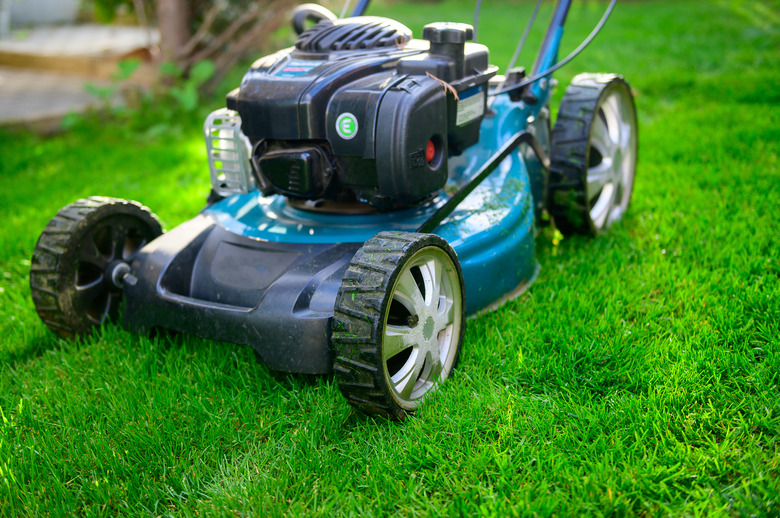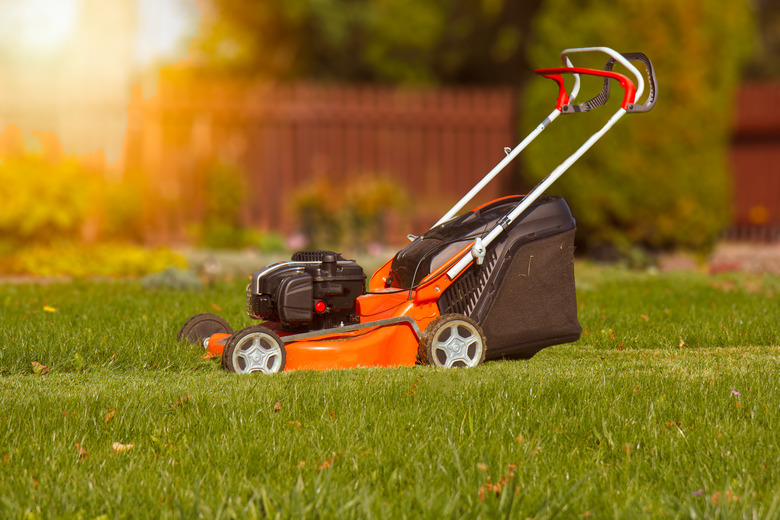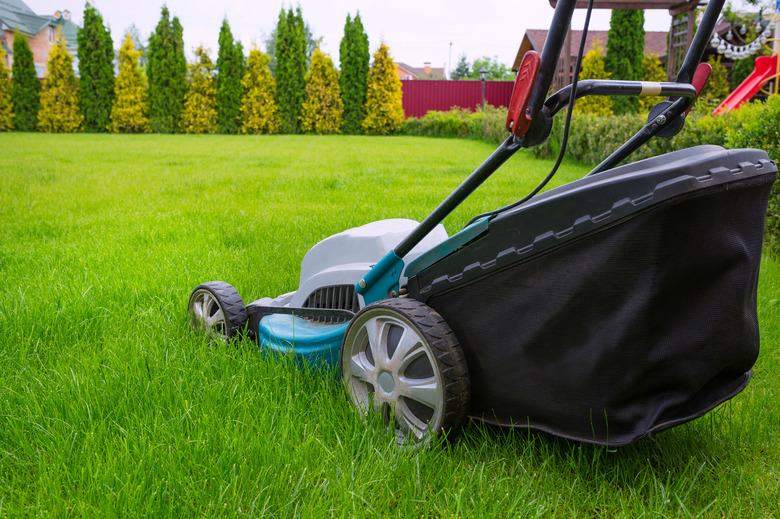Homeowner's Guide To Winterizing And Storing A Lawn Mower
All it takes is one sunny day in spring, when the grass is having its first growth spurt and you finally have time to mow it, to realize the importance of winterizing your lawn mower. You retrieve your trusty mower from the garage or basement, fill the gas tank, pull the cord and — well, you probably know how this story turns out. The small amount of fuel you left in the gas tank over the winter has clogged the carburetor, and your day of mowing has to wait until you or someone else cleans it.
Winterizing your lawn mower involves a number of fairly easy tasks that may consume a few hours of your time in the fall to prepare for a busy mowing season when the weather turns warmer. If you can't spare that much time, three tasks are essential and will take less than 30 minutes, and if you do them, your mower will be raring to go in spring. That doesn't mean it will be in tip-top shape, though, and if that's what you want, it's well worth it to go the extra mile and run through the complete winterizing checklist.
Add Fuel Stabilizer
Add Fuel Stabilizer
The number-one mistake homeowners make is to leave a lawn mower, chainsaw, trimmer or other gas-powered garden tool in the shed with old fuel in the gas tank. If you bought the fuel at a gas station, it probably contains ethanol, which is a magnet for moisture, and unless you store the mower in the house, there's bound to be plenty of moisture in the air. Moisture dissolves some of the solids in the gas and seeps into the tiny orifices in the carburetor, effectively clogging it.
"OK," you say, "I guess I should drain the gas tank." While that's better than leaving old gas in it, it isn't the ideal solution unless you store the mower in the house. In that case, it's a good idea to drain the tank because the house is dry and, after all, gas is flammable. In the shed or garage, however, moist air will circulate through the empty tank and fuel system and rust the tiny metal parts, and while you might not notice the effects during the first spring start-up, you will notice them eventually. The life of the carburetor and the lawn mower will be shortened.
The right way to store the lawn mower is to add stabilizer to the gas in the proportion recommended on the label and fill the tank 95 percent full. Start the engine and let the motor run for a minute or two to circulate the stabilized gas throughout the fuel system and then shut it down. The carburetor and fuel system are now protected from moist winter air.
Clean the Lawn Mower Deck
Clean the Lawn Mower Deck
If you're going to do only two lawn mower winterizing tasks for your rotary mower, the second one should be to remove the buildup of old grass clippings from the top and underside of the mower deck. Grass is also a magnet for moisture, and the longer it stays glued to your metal lawn mower, the more likely it is that the metal will corrode. You can do this without removing the mower blade, but that's so easy to do and takes so little time that it makes no sense not to do so. You can set the blade aside and give it a good sharpening before you reinstall it, and you'll thank yourself in the spring.
To clean the mower deck, it helps to have a scrub brush handy, but at the very least, you should have a stiff putty knife. Disconnect the spark plug before you begin and then use the brush or the putty knife to dislodge the caked-on mats of clippings that are common on the undercarriage of a well-used mower. Use a garden hose with a nozzle set to the jet function to make this job easier, and when you're done, turn the mower upright and wash off the top deck as well. Avoid spraying directly at the air filter; you don't want any water to seep past it and get into the carburetor.
Disconnect and Remove the Battery
Disconnect and Remove the Battery
If you have a cordless mower or a gas-powered mower with an electric starter, it goes without saying that you should disconnect and remove the battery for the winter, so this is the third essential task. Leaving the battery hooked up for several months of cold, wet weather will discharge it, and the terminals will corrode, not to mention that you don't want anyone to accidentally turn over the engine while the mower is in hibernation.
Drain the Lawn Mower Oil
Drain the Lawn Mower Oil
If your lawn mower has a four-stroke engine, it has a separate compartment for oil, and it's a good idea — although not absolutely essential — to empty it. Oil isn't as prone to moisture retention as gasoline, but it does contain sludge from the engine, which can settle out and clog the lubrication system. To drain the oil, place a large pan on the ground, tip the lawn mower on its side and let the oil drain into the pan. Discard the old oil responsibly by taking it to a disposal site, such as the local dump or an automotive parts store, and fill the crankcase with fresh oil in the spring.
Replace the Spark Plug
Replace the Spark Plug
This isn't exactly a winterizing task, but won't it be nice when you fire up the lawn mower in the spring and it starts up right away? Replacing the spark plug is one of those maintenance tasks that's easy to forget, and one way to remember to do it is to make it part of your winterizing routine. A lawn mower spark plug is inexpensive and easy to find, and all you have to do is pull off the spark plug wire, unscrew the old plug with a spark plug wrench, lubricate the internal threads by dipping a rag in oil and wiping them down, screw in the new plug and push the wire cap onto the end of the plug.
Replace the Air Filter
Replace the Air Filter
Again, it's not an essential winterizing task, but homeowners commonly forget to clean or service the air filter on the lawn mower, and since it's inexpensive and performs the essential function of keeping dirt particles out of the carburetor, it should be part of your end-of-season routine. The removal procedure is usually self-explanatory, but if you need the owner's manual to explain it and you lost your paper copy, you can usually find one online on the manufacturer's website.
Sharpen the Lawn Mower Blade
You took the blade off your rotary mower to clean the buildup of grass clippings from the undercarriage, and now that it's off, why not sharpen it? This is a job you can do yourself if you have a bench grinder, but if not, take it to the hardware store and have it done for you.
If you do it yourself, remember to grind both ends equally. A good way to tell if you're doing this is to hang the blade on a nail; if it's balanced, it will hang horizontally. You'll have one less thing to figure out if you mark the side of the blade facing you with spray paint before you remove it so you know which way it goes when you put it back.


